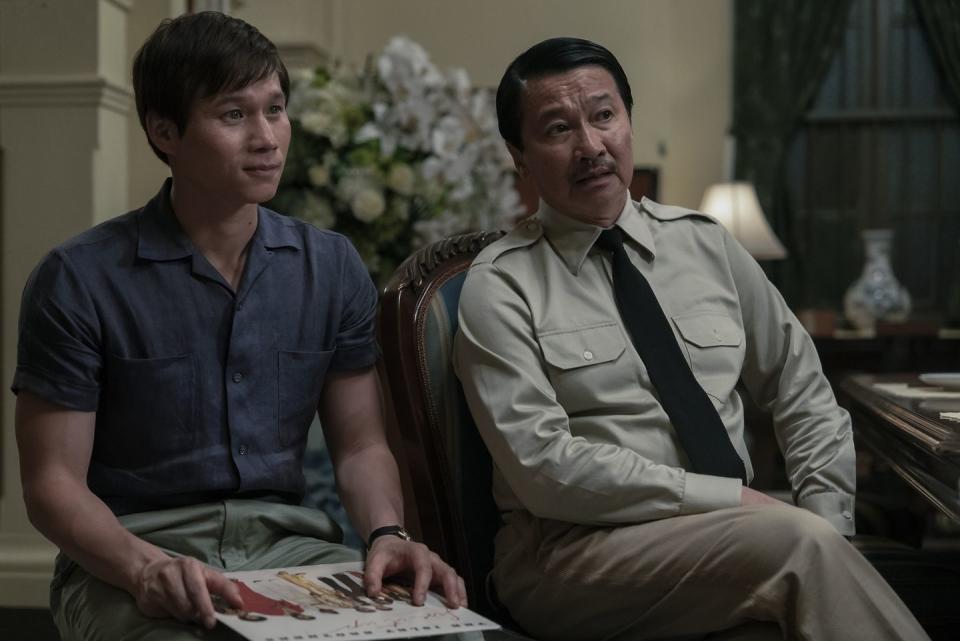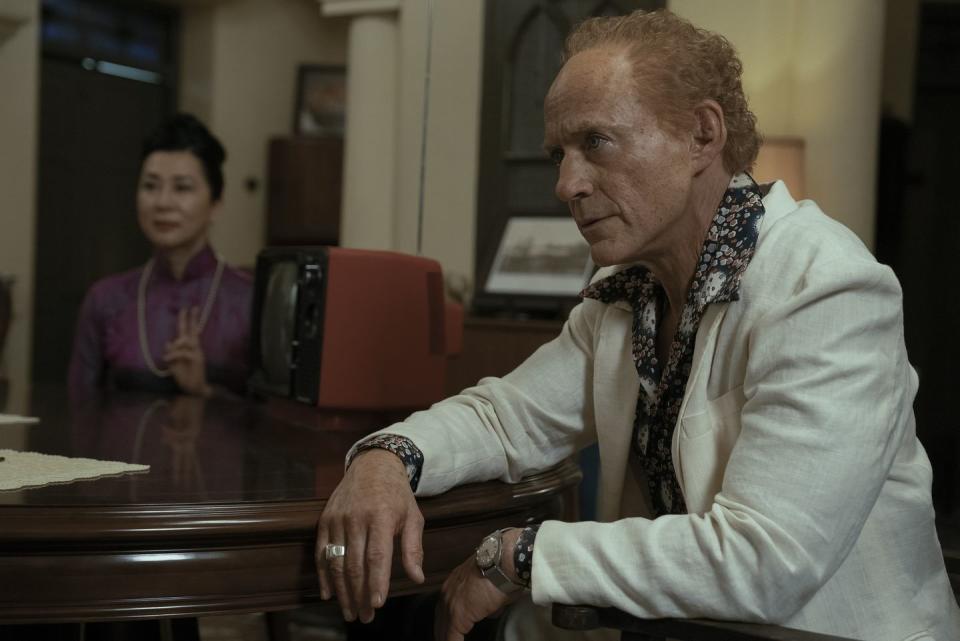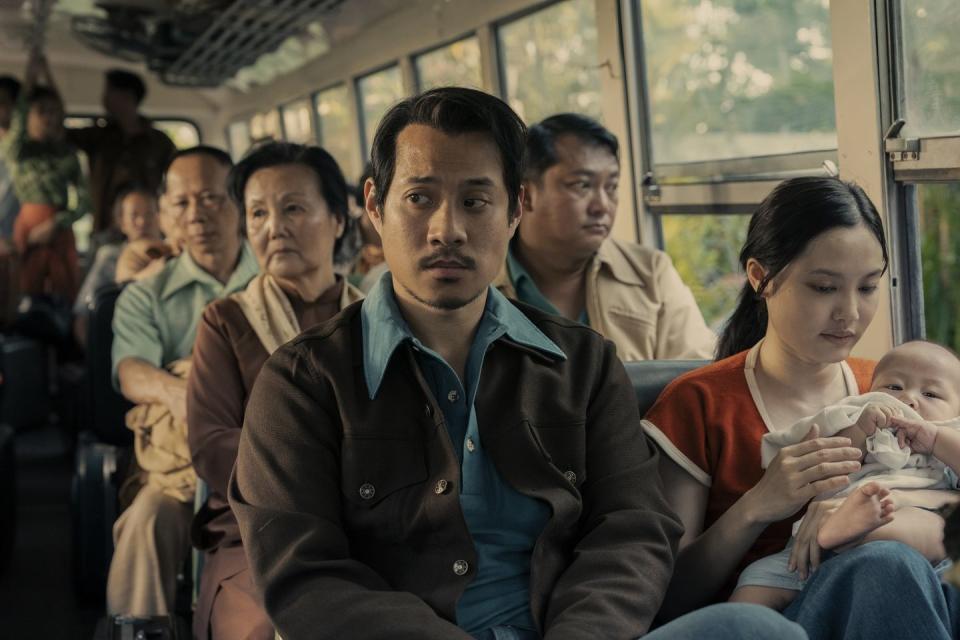We Decoded the Thrilling Premiere of ‘The Sympathizer’

Television has taught us a lot about Asian history lately, hasn’t it? FX’s Shōgun sent audiences back in time to 17th-century Japan. Netflix’s 3 Body Problem begins during China’s Cultural Revolution. Now HBO’s The Sympathizer kicks its thrilling story off with the Fall of Saigon in Vietnam. None of this is a complaint, of course. We could all use a little world-history refresher—and the information I’ve received in prestige TV in 2024 is invaluable. (Especially when I cover all three of these series.)
The Sympathizer, which debuted on HBO this Sunday night, introduces us to the Captain (Hoa Xuande), a member of the South Vietnamese Army in 1975. The Captain is secretly a spy for the North. He reports the activities of his superiors—the General (Toan Le) and CIA agent Claude (Robert Downey Jr.) back to the Vietcong. He’s a communist sympathizer (hence the title of the show), but HBO’s adaptation of Viet Thanh Nguyen’s award-winning novel doesn’t delve into the Captain’s specific motivations in the premiere episode—outside of a sense of righteousness in his mission.
The Captain’s dualities do not end there. He is half Vietnamese and half French, which is a point of contention in just about every room he walks in. Is he Vietnamese enough for his mission? Does he sympathize enough? He also attended college abroad in the U.S., where he learned to speak impeccable English. Will his newfound love of American freedom and Coca-Cola impact his fight for his people back home? As the Captain says in The Sympathizer’s opening minutes, “I was cursed to see every issue from both sides.”
In the first episode, we’re nearing the end of the Vietnam War. But as The Sympathizer reminds us in the opening title crawl, the conflict is called the American War in Vietnam. There’s always two sides to every tale—and the Captain sees both of them. The U.S. aided South Vietnam in its fight against the North, but the war’s cost of American lives greatly hurt its reputation back in America. When the U.S. finally pulled out of the country in 1973, the Vietcong took control. Saigon, the capital in the South, fell to the North. More than 7,000 South Vietnamese fled their home in a U.S.-backed evacuation mission titled Operation Frequent Wind. That’s all true. But in this work of historical fiction, the Captain is among them.

Arriving there is no small feat. To prove it, The Sympathizer begins four months before the Fall of Saigon. To be fair, the show really starts at the end of our story, when the Captain is captured by his own people, but I’ll save you the confusion (for now) and tell the story in chronological order.
At a movie theater, the General and Claude interrogate a communist sympathizer who was allegedly captured by the Captain. Throughout his mission, the Captain is occasionally forced to help the South Vietnamese to maintain his cover. Unfortunately for the woman onstage, this is one of those trying times. To cut the tension of a scene in which a woman is attacked onstage for information, The Sympathizer cracks some movie puns. Outside, there’s a poster for Death Wish, the 1974 Charles Bronson movie. The spotlight from a film projector plays the role of a bright lamp in an interrogation room—and the interrogators taunt her by calling her a “diva” who should “perform” for her audience. When they ask her for the name of her contact in the North, she stares venomously at the Captain.

The General and Claude are none the wiser. The Captain lives as a servant in the General’s house, where he teaches English to the General’s daughter and picks up his dry cleaning. He’s basically part of the family. As he sits with his superiors, the General is more concerned with what to wear to dinner than what their prisoner has to say. The woman reportedly swallowed a roll of microfilm, so the CIA is waiting to see what it contains when it comes back out the other end. As Claude tells him, “This is counterintelligence. It gets wet down here.” Claude is just one of several antagonists that Downey plays in The Sympathizer, but we won’t spoil any of the other characters just yet.
Although the prisoner won’t reveal what the microfilm contains, the Captain knows exactly what they’ve found. A couple days earlier, our main character stole a complete staff list for the South’s secret police from a locked filing cabinet in the General’s office. Ironically, once the plans for Operation Frequent Wind were set, the General personally handed him the list. He ordered the Captain to decide who boards the evacuation plane and who stays behind. So the Captain selects the weakest members among them. His only request? A place for his friend Bon (Fred Nguyen Khan) and Bon’s family.
Even though Bon despises the Vietcong for killing his father in the war, he mysteriously remains one of the Captain’s closest friends. A doctor named Man (Duy Nguyễn), the third member of the “Three Musketeers,” is also secretly a communist sympathizer. The Captain receives his true orders from Man, who must also exist somewhere in the chain of command for the North. They exchange messages using a secret code derived from Asian Communism and the Oriental Mode of Destruction—a fictional book by a racist foreign-policy expert in America. (Also, if you’re waiting for the Captain’s real name, you’ll likely never get it. The novel never reveals it, either. So it’s just Captain from here on out. Same goes for the General.)

Part of the evacuation crew himself, the Captain pushes Man to arrest the General and his men before they can escape. Man reveals that the North has other plans in mind. Should the General safely evacuate Vietnam, the North will need “someone with the General to keep an eye on him and report back.” The Captain can’t believe it. “I’ve been living underground for three and a half years, fighting, yearning for the day of victory,” he tells him. “I want to be here and celebrate. And to help build our future! When the plan arrives and everyone’s on board, I’m going to walk up to the General and say, ‘Bon voyage, I’m staying home.’” Sorry, Captain—that’s not going to happen. As Man tells him, “Home is overrated.”
In a flash of horrific CGI and a blood-red skyline, the evacuation night is a disaster. The Vietcong rain hellfire down on the passengers as they run from a crowded bus to the airport tarmac. They’re sitting ducks out there. In the chaos, the Captain helps the General and Bon successfully board the plane. Bon’s wife and child are killed in the assault, greatly increasing the likelihood that his friend would attempt to kill him if he ever found out he was a spy. For the Captain’s sake, I hope that event never comes to pass. But as a member of an audience watching a television show for the tension and drama, I really hope it does.
You Might Also Like


